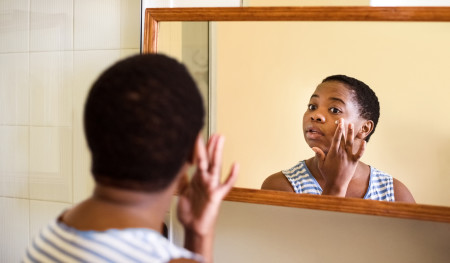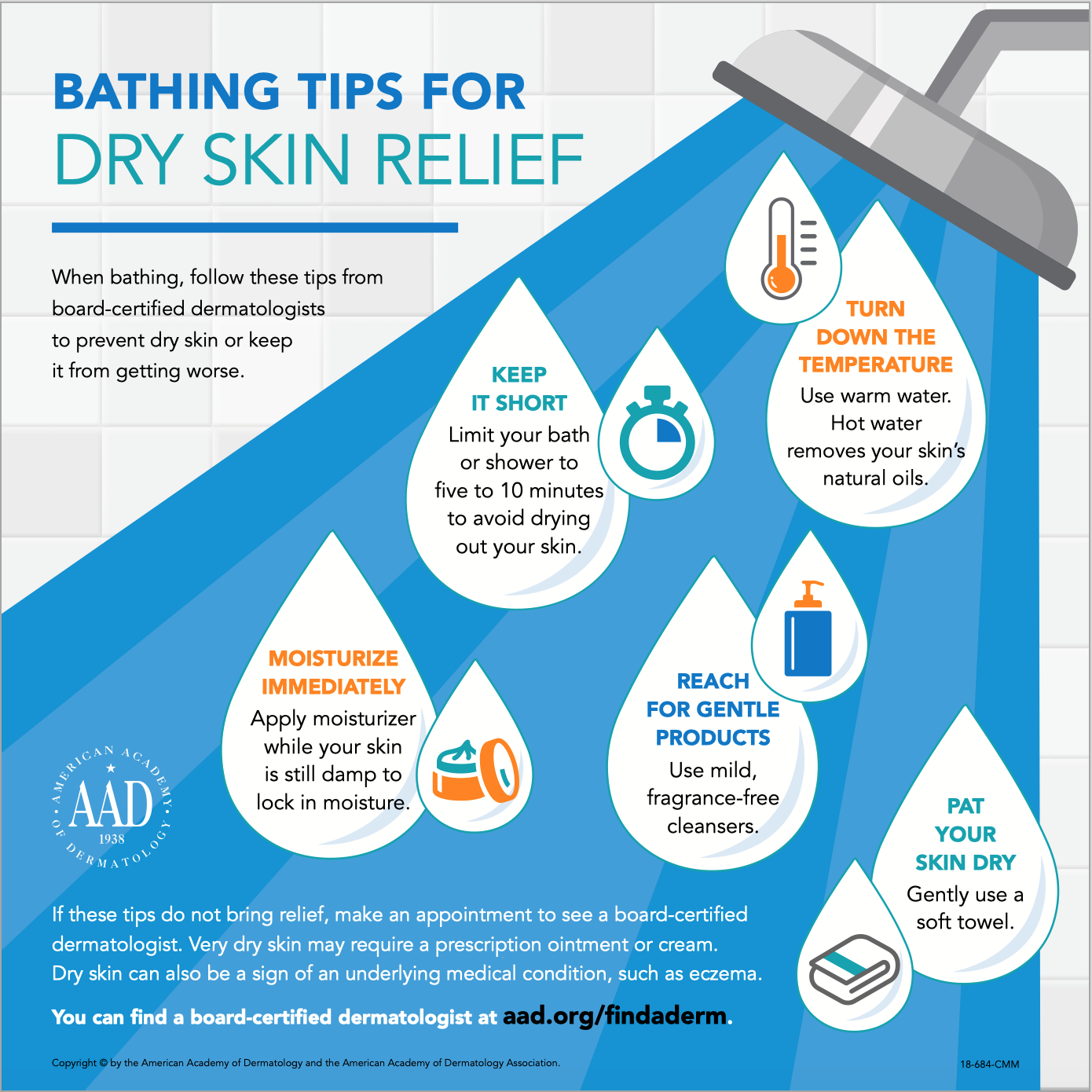Dry skin: Tips for managing
Moisturizer relieves dry skin
To help heal overly dry skin, apply a cream or ointment when your skin feels dry and take time to gently massage the moisturizer into your skin.

To help heal overly dry skin, apply a cream or ointment when your skin feels dry and take time to gently massage the moisturizer into your skin.
Many people can heal dry skin at home on their own. To get relief, this is what dermatologists recommend: Dermatologists top tips for treating dry skin
If you continue to have dry skin after trying the top tips that dermatologists recommend, it’s time to see a board-certified dermatologist. Your overly dry skin may be due to an underlying medical condition, such as atopic dermatitis, psoriasis, or kidney disease.
Without treatment for the condition, both your dry skin and the condition can worsen.
It’s also possible that something you’re doing at home or work is causing your dry skin. To get relief, you may need to make some changes.
A board-certified dermatologist has the in-depth expertise required to find what’s causing your dry skin and tailor a treatment plan to your needs.
Self-care plays an important role in this treatment plan. Here’s what you can do at home to help heal excessively dry skin.
Follow your treatment plan. If you have excessively dry skin, your skin needs the right balance of active ingredients to heal. Your dermatologist will prescribe (or recommend) a moisturizer that provides what your skin needs. Some patients need a combination of urea and ceramides in their moisturizer. For others, dimethicone, which seals in moisture, is key. You may also need to apply a medication, such as a corticosteroid, for a short time. If you have an underlying medical condition, such as atopic dermatitis or psoriasis, treating the condition can bring relief. Your dermatologist can create a treatment plan for a skin condition.
Keep all your dermatology appointments. Your treatment plan may need fine-tuning as your skin heals. This is also your opportunity to tell your dermatologist if you have trouble following your treatment plan.
Does lotion cause pain?
Does anything you apply to your skin (including moisturizer) cause burning, stinging, or irritation? Tell your dermatologist.

Apply moisturizer several times a day. Moisturizer plays a key role in healing dry skin. Be sure to apply your moisturizer within 5 minutes of taking a shower or bath, after washing your hands, and when your skin feels dry. You want to apply the right amount and take time to gently massage the moisturizer into your skin. If you’re unsure how much to apply, contact your dermatologist.
Use a humidifier. Dry skin needs moisture. You can boost the humidity level in your home with a humidifier. Some home heating systems have a humidifier. You can also use a portable humidifier. If you use a portable humidifier, place it in your bedroom and run it while you sleep.
Wash your skin with a gentle cleanser. Dry skin is damaged skin. To avoid irritating your skin and help it heal, use a gentle, fragrance-free cleanser. A deodorant soap or body wash with fragrance can worsen dry skin. Use the fragrance-free cleanser only where you need it, such as your armpits or groin area. Tip: Use only fragrance-free products. “Fragrance free” and “unscented” have different meanings. Unscented generally means the product contains a chemical that covers up the smell of other ingredients so that you cannot smell them. Unscented products can irritate excessively dry skin. To avoid this, use fragrance-free products.
Limit baths and showers to five minutes, using warm (not hot) water. Hot water strips skin of moisture, which worsens dry skin. A five-minute shower or bath in warm water can add moisture to your skin. To dry off after bathing, gently pat your skin with a clean, dry towel. Rubbing your skin dry can irritate extremely dry skin. Leave your skin a little damp and then apply your moisturizer (preferably a cream or ointment). Doing this within five minutes of bathing will help seal moisture into your skin.
Shave at the end of your shower or bath. When you finish your shower or bath, gently pat your skin dry and immediately apply your fragrance-free moisturizer.
Wear gloves. If you wash dishes, garden, or immerse your hands in water throughout the day, you can worsen your already dry skin. Wearing gloves that keep your dry skin from getting wet can help your skin heal.
Protect your skin from the cold. When you have dry skin, cold air can worsen dry skin. Wearing gloves in the winter that keep your hands warm can help. If your job requires you to work outdoors in the cold or in a commercial refrigerator, be sure to protect your hands with gloves.
Avoid the sun and tanning beds. Both the sun and indoor tanning equipment emit UV rays, which dry the skin. To protect your skin from the sun, seek shade. You also want to wear clothing that protects your skin, such as a wide-brimmed hat, long sleeves, and pants. For any skin that clothing will not cover, apply a fragrance-free sunscreen that offers broad-spectrum protection and SPF 30 or higher.
Wear loose-fitting cotton clothes. Tight clothes, such as leggings and body-hugging jeans, rub against your skin, which can worsen dry skin. Wearing clothing made of wool or polyester against your skin can also irritate dry, sensitive skin. To prevent irritating your skin, wear loose-fitting cotton clothing.
Ask your dermatologist before using anti-itch creams and other skin care products. Extremely dry skin can itch. To get relief, people often buy an anti-itch cream or other product that promises relief. Before using this, ask your dermatologist. Many of these products contain ingredients that can irritate your overly dry skin, making the dryness and itch worse.
When you follow your dermatologist’s treatment plan and self-care tips, you can relieve the driest skin.
If you need a dermatologist, you can find one by going to: Find a dermatologist
Related AAD resources
Image: Getty Images
References Augustin M, Wilsmann-Theis D, et al. “Diagnosis and treatment of xerosis cutis - a position paper.” J Dtsch Dermatol Ges. 2019;17 Suppl 7:3-33. Terrie YC. “Itchy, scratchy skin: Preventing and managing xerosis.” Pharma Times. Posted 6/18/2013. Last accessed 2/7/2020.

 Atopic dermatitis: More FDA-approved treatments
Atopic dermatitis: More FDA-approved treatments
 Biosimilars: 14 FAQs
Biosimilars: 14 FAQs
 How to trim your nails
How to trim your nails
 Relieve uncontrollably itchy skin
Relieve uncontrollably itchy skin
 Fade dark spots
Fade dark spots
 Untreatable razor bumps or acne?
Untreatable razor bumps or acne?
 Tattoo removal
Tattoo removal
 Scar treatment
Scar treatment
 Free materials to help raise skin cancer awareness
Free materials to help raise skin cancer awareness
 Dermatologist-approved lesson plans, activities you can use
Dermatologist-approved lesson plans, activities you can use
 Find a Dermatologist
Find a Dermatologist
 What is a dermatologist?
What is a dermatologist?
